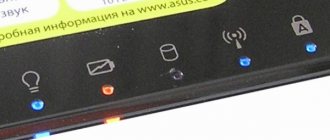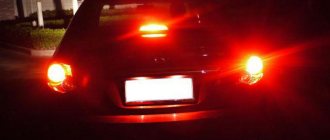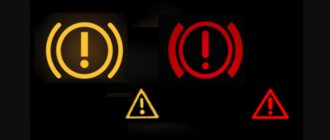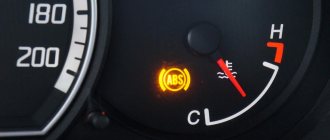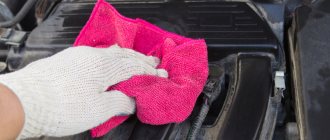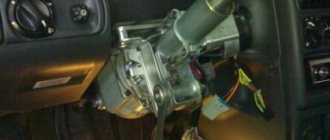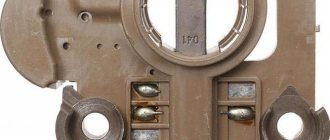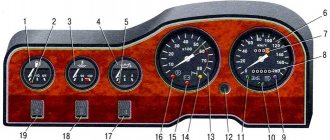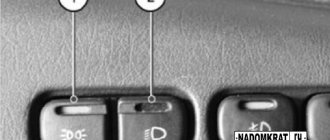Like any car, the IS also has problems that often become a puzzle for the average car mechanic.
This time the problem was the brake system malfunction indicator (a light indicating that the hand brake has been lifted). It lights up and doesn't go out. We started looking at the handbrake, thinking that the button was stuck. No, when you lift it, a beep appears, which means the chip and the button are ok. Next we checked the brake fluid level - NORMAL. When the methods of “scientific poking” ended, they took us to the master. Without hesitation, the master plugged in the computer and fiddled around, but couldn’t find anything. His conclusion was as follows: leave the car so he could ring the wiring, maybe one of the sensors is acting up or the contact is exposed and shorted to something.
This, of course, made me think and go Google, which gave me several reasonable, and most importantly simple, directions for action. By studying circuit diagrams, including electrical circuits, books on car maintenance and other things, as well as by the method of elimination, 4 main possible causes were identified.
So, a simplified version
Problem:
The light on the dashboard is on (and does not go out), indicating a malfunction of the brake system.
Possible reasons:
(if the indicator does not light up when you start the car, but lights up when you press the brake pedal, then most likely you can skip the 1st point) 1. Brake fluid level sensor 2. Brake pad wear 3. Central brake light lamp 4. Button or chip handbrake
Diagnostics:
1. The electrical circuit diagram is designed in such a way (including the structure of the sensor - it gives a signal only when the liquid level is low) that if you disconnect the reservoir sensor chip with the brake, then the comp. will think that the level is normal. Therefore, disconnect the chip, and if the indicator goes out, then the problem is there. 2. If the wear of the pads is very large, the fluid level may drop when pressed and the indicator will light up. 3. If disconnecting the chip (see step 1) did not have any effect, then you probably have this exact problem. Press the brake and see if the central brake light is on. If it doesn't light up, that means it's the problem. 4. With the car running, raise the handbrake, if a sound signal appears, then everything is in order, if there is no sound, it makes sense to look
Why does the indicator ((!)) appear?
The brake system consists of a mechanical part (discs, pads, brake fluid, lines, etc., manual or electric parking brake) and an electronic part - a set of sensors and wiring.
Only on certain car models, signals from different sensors are indicated by the lighting of individual lamps, and then the letter ((P)) on the dashboard indicates that the handbrake is engaged, and the icon ((!)) indicates a malfunction of the main brake system.
Often, cars have only one warning lamp, which receives signals from the brake fluid level sensor, pad wear, brake light and handbrake.
Reasons for ABS system failure and what to do
Water getting into the contacts of the ABS control unit
We find the system control unit under the hood. It usually looks like a rectangular iron box with several metal tubes. There may be five or four of them. This is the anti-lock braking system unit. The power and control connector is connected to it - a large plug, it only fits the case, you won’t get it mixed up.
Disconnect the negative terminal of the battery and disconnect this connector from the ABS control unit. We check its contacts for moisture or mechanical damage. There were cases when they rotted and were destroyed by age and water, despite the moisture-proof casing of the connector. It may be damaged, allowing water to penetrate inside.
If you find moisture inside, blow and dry the plug and contacts both on it and on the control unit. If there is visible damage to the contacts of the plug, only replace it; if there is visible damage to the contacts of the ABS computer, then contact specialists who can replace the connector.
Fuse box
This is the simplest thing that a simple driver can check on his own if the ABS light comes on. It is advisable to check them first - this is the easiest way. We wipe our hands and climb under the hood, looking for a mounting block - a plastic box with fuses and relays.
Open it and turn over the top cover. It usually says where and what fuses are located in the block. We find the inscription “ABS” and according to the diagram we look for the fuse that is responsible for this system.
Checking the fuse. Usually there should be spare fuses in the mounting block if the machine is completely new. If there are none, then you can use the adjacent fuse. For example, remove a fan, horn, or other less important systems that were definitely working from the power socket. And insert in place of the old ABS fuse.
Mud and snow
Further verification becomes a little more complicated. The sensors are located on the wheel hubs. Snow or dirt may stick between them and the gear, also called the ABS ring. They stop reading the rotation speed, and the ABS error light comes on.
The main elements on the dashboard of a car are the tachometer, speedometer, fuel level and coolant temperature. In modern cars, the instrument panel has a large number of different indicators informing the driver about the condition of the car and its possible malfunctions.
In this article we will talk about the indicator in the form of a red exclamation mark on the Lada Kalina car, namely, you will get the answer to why the red exclamation mark lights up in the car and so frightens drivers who do not know its purpose.
How to define the problem more accurately
If the indicator lights up during hard braking, this is an argument in favor of the version with worn pads. The solution is to replace the pads.
If the light periodically goes out, this may be due to the fact that the liquid splashes in the tank during driver maneuvers, and at some moments its level is below the diagnostic float. The solution is to check the tank and add DOT to the level.
ABS lamp lights up along with the indicator ((!)) , this indicates that the ABS sensor has failed.
On Renault models with an electronic handbrake, the “Brake” lamp may come on due to a faulty parking brake sensor.
How does a mechanical handbrake work? Let's consider its principle of operation
Looking through the list of internal parts of this mechanism, we notice only one - a lever. There are cases when it can be replaced by a small pedal, located somewhat away from the main pedals responsible for driving the car. Using a number of parts, as well as tensioners and fuses, the lever is connected to mechanisms that block the rear wheels.
A ratcheting wheel is installed in the lever itself; it fixes the operating mode and is a safety device. The force transmitted by the driver is distributed over two or three cables, which are connected to the pads through special parts. A scheme with three parts is often used, these are two side ones that lead to two rear wheels, but the central cable plays an important role in the distribution of the applied forces. The drives are connected to each other through the main part - the block.
Specially designed levers are necessary to control the operation of the pads. There is their connection with the right and left cables in a situation when the lever is turned on and the fuse is triggered, they will precisely press the handbrake pads to the walls of the drums or rotors. All the main parts of the parking mechanism are aligned using tips that have a length that can be adjusted. If the cables are stretched, this will allow the tension to be adjusted to them without replacing all the internal components of this system. The manual parking mechanism is not the only representative; there is also a hydraulic type and an electronic one, which also have fuses.
What to do if the lamp ((!)) lights up while moving
Be prepared for the worst - brake failure. Turn on the emergency lights and carefully check whether the brakes respond to pedal pressure.
- If the pedal fails, try to “bleed” the system with a few strong presses.
Look for a place to stop, slow down using engine braking or applying the parking brake.
After stopping, check the brake fluid level. Further options are possible.
If the DOT level is OK, check the condition of the handbrake and the condition of the brake lights:
- Find the handbrake sensor (in a situation with an electric parking brake - right under the button), put the car on the handbrake and press the sensor rod. If the brake system indicator goes out when pressed, the reason is a faulty sensor.
- ask your assistant to depress the pedal (or press it down with improvised means) and inspect the lights yourself.
Why does the ABS light keep blinking and turn on randomly?
If the ABS indicator flashes continuously or lights up, this indicates a disruption in the transmission of system signals. This is a sign of serious problems, so most drivers try to disable the ABS system to avoid problems. If the car starts to slow down on its own at a speed of about 90 km/h, this is not only a loss of controllability, but also a breakdown of the chassis.
Actions in this case:
- Disable the ABS by removing the fuses from the block;
- Find the fault and fix it yourself, if possible;
- Contact a service station for diagnostics and repairs;
- If it is impossible to turn off the ABS, stop the car and call a tow truck;
Checking the brake fluid level sensor
Release the parking brake and check the brake fluid level in the reservoir.
If the fluid level in the tank is below the “MIN” mark, and the corresponding icon in the instrument cluster does not light up, press the latch and disconnect the block with wires from the sensor. We close the contacts of the wiring harness block with a piece of wire.
- If the lamp does not light up, then there is a break in the car's wiring.
- If the lamp lights up, the sensor is faulty.
If the fluid level is normal (between “MIN” and “MAX”), and the warning lamp continues to light after starting the engine, press the latch and disconnect the block with wires from the sensor.
- If the lamp goes out, the sensor is faulty.
- If the light remains on, there is a short circuit in the vehicle's wiring or the instrument panel is faulty.
The sensor is replaced together with the brake master cylinder reservoir. A malfunction of the brake system is also indicated by burning ABS and ESC lamps.
The brake light on the instrument panel is on: causes, diagnosis, solution to the problem
The reliability of a car's braking system directly affects the safety of passengers and drivers around it. The brakes must function smoothly and respond promptly when the driver presses the pedal.
On the dashboard of cars there is a special indicator that notifies the driver about problems in the braking system, it is also popularly called the “handbrake indicator”. Most often it looks like an exclamation mark, with curved lines to the left and right of which there are curved lines; it can also have the inscription Brake on it. If the brake light is on, it is prohibited to go on a trip until the reasons for its activity are clarified.
Let's sum it up
The diagnostic system in Volkswagen Group cars is of quite high quality and boasts high efficiency. You can use the auto self-diagnosis capabilities in cases where you are not sure of the serviceability of all modules and sensors. In most situations, mistakes take us by surprise and not at the best time. For this reason, many drivers always carry the manufacturer's original instructions with them. However, they do not contain particularly useful information. To resolve any problem, the instructions recommend “contact your nearest Volkswagen service center.”
It is best to find specialists for your car brand who can help you over the phone. In this case, service from one specialist will be a big advantage. If the person knows the car, they will be able to tell you over the phone where to look to fix the problem. You can even solve the problem on the highway and calmly go on your further journey. Using the diagnostic capabilities and effective testing of systems in your car, you will always be confident in the high-quality operation of the car. Have you ever been scared by terrible errors with incomprehensible inscriptions in German?
Source
FakeHeader
Comments 18
I’m telling you how it was for me, and how it is now. The light bulb also blinked, then it was on, then it was not lit, then it burned for a long time, then it went out. Briefly speaking. My right rear caliper was leaking and the brake fluid was gone. I topped up the brake fluid, changed the brakes to new ones from G4, the light does not blink, but you can see that it is barely burning, although the level is normal. It turned out that the float on the tank cap was biting. The price of a cork is pennies. I ordered it, but it hasn't arrived yet.
The lamp lights up in 3 cases: 1. Handbrake 2. Signal from the fuel fluid sensor in the tank. 3. Low pressure in the system (the pump does not pump if the car has ABS).
I think you either have too little fuel pressure, or there are problems with the contact of the handbrake or the contacts of the sensor in the tank.
It looks like the pads need to be replaced, but check that they are thick enough?
The B3 does not have a pad sensor.
How are you driving, is everything ok? Maybe check the handbrake, where is the sensor clogged?
The light comes on due to the brake fluid level, check the wheel cylinders for leaks, and look at the hydraulic clutch drive. The level may drop due to wear on the front pads especially, the piston is pushed out more, and its place is taken by brake fluid from the barrel.
Atvechayu! Hey brothers, that’s the moment I had! Handbrake, slurry... the options are good... How do you like this situation... I had... passed... By some magical means, moisture got under the cap on the lid of the brake reservoir (yes, it is collapsible... As a result of which there was contact, and the light came on... Cured disassembly, cleaning!
I confirm, slow down!
I had a plastic insulator on the handbrake terminal come off and it sometimes short-circuited) I pull the handbrake - everything seems to be normal... sometimes it blinks, sometimes it doesn’t.
100% lights up due to brake fluid level
the problem is simple. It lights up and goes out because the fuel fluid level in the tank changes in the pits, add the level to the maximum and check whether the sensor is seated tightly in the tank. The option with a handbrake, as a rule, has life, but I doubt that the handbrake on the limit switch jumps or the “+” or “-” chip comes off
that's it! everything is exactly right!
There are two consequences - either the handbrake limit switch or a low level of brake fluid in the reservoir, but the cause can be very unpleasant - there is a brake fluid leak somewhere. I had this situation - the rear brake cylinder leaked. So do an inspection for leaks.
(((I'll watch it tomorrow...
There are two consequences - either the handbrake limit switch or a low level of brake fluid in the reservoir, but the cause can be very unpleasant - there is a brake fluid leak somewhere. I had this situation - the rear brake cylinder leaked. So do an inspection for leaks.
I looked at the rear brake cylinders, everything is dry, everything in front is also normal, the only thing that confused me was when I decided to remove the chip that is on the lid of the reservoir, took off the rubber cover, one wire was held on by one tendril and then it completely came off ((((and everything was oxidized( ((( took the terminal block apart, cleaned everything and did it right... maybe there was a problem there...
Publication date December 27, 2022. Published in Renault Secrets
There is no need to talk about the importance of a working brake system. Along with the emergency oil pressure and antifreeze overheating lamp, the “Brake” or (!) lamp is the signal upon which the driver must stop or not start the trip. At least until he finds out the cause of the malfunction.

